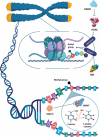Epidrugs: targeting epigenetic marks in cancer treatment
- PMID: 31282279
- PMCID: PMC6791710
- DOI: 10.1080/15592294.2019.1640546
Epidrugs: targeting epigenetic marks in cancer treatment
Abstract
Growing evidence suggests that aberrant epigenetic regulation of gene function is strongly related to the genesis of cancer. Unlike genetic mutations, the ability to reprogram the epigenetic landscape in the cancer epigenome is one of the most promising target therapies in both treatment and reversibility of drug resistance. Epigenetic alterations in cancer development and progression may be the basis for the individual variation in drug response. Thus, this review focuses on the emerging area of pharmaco(epi)genomics, specifically highlighting epigenetic reprogramming during tumorigenesis and how epigenetic markers are targeted as a therapy (epidrugs) and the clinical implications of this for cancer treatment.
Keywords: Epigenetics; cancer; epidrugs; pharmacology; reprogramming; treatment.
Figures


Similar articles
-
Cancer epigenetics: Moving forward.PLoS Genet. 2018 Jun 7;14(6):e1007362. doi: 10.1371/journal.pgen.1007362. eCollection 2018 Jun. PLoS Genet. 2018. PMID: 29879107 Free PMC article. Review.
-
Towards a more precise therapy in cancer: Exploring epigenetic complexity.Curr Opin Chem Biol. 2020 Aug;57:41-49. doi: 10.1016/j.cbpa.2020.04.008. Epub 2020 May 29. Curr Opin Chem Biol. 2020. PMID: 32480315 Review.
-
Targeting the epigenetic regulation of antitumour immunity.Nat Rev Drug Discov. 2020 Nov;19(11):776-800. doi: 10.1038/s41573-020-0077-5. Epub 2020 Sep 14. Nat Rev Drug Discov. 2020. PMID: 32929243 Review.
-
Targeting Epigenetics in Cancer.Annu Rev Pharmacol Toxicol. 2018 Jan 6;58:187-207. doi: 10.1146/annurev-pharmtox-010716-105106. Epub 2017 Oct 6. Annu Rev Pharmacol Toxicol. 2018. PMID: 28992434 Free PMC article. Review.
-
Epigenetic marvels: exploring the landscape of colorectal cancer treatment through cutting-edge epigenetic-based drug strategies.Clin Epigenetics. 2025 Feb 22;17(1):34. doi: 10.1186/s13148-025-01844-w. Clin Epigenetics. 2025. PMID: 39987205 Free PMC article. Review.
Cited by
-
Epigenetic Modifiers in Cancer Metastasis.Biomolecules. 2024 Jul 27;14(8):916. doi: 10.3390/biom14080916. Biomolecules. 2024. PMID: 39199304 Free PMC article. Review.
-
NOTCH3 inhibits transcription factor ZEB1 expression and metastasis of breast cancer cells via transcriptionally upregulating miR-223.J Cancer. 2024 Jan 1;15(1):192-203. doi: 10.7150/jca.89034. eCollection 2024. J Cancer. 2024. PMID: 38164285 Free PMC article.
-
The role of RNA modification in urological cancers: mechanisms and clinical potential.Discov Oncol. 2023 Dec 20;14(1):235. doi: 10.1007/s12672-023-00843-8. Discov Oncol. 2023. PMID: 38117350 Free PMC article. Review.
-
Modulating epigenetic modifications for cancer therapy (Review).Oncol Rep. 2023 Mar;49(3):59. doi: 10.3892/or.2023.8496. Epub 2023 Feb 17. Oncol Rep. 2023. PMID: 36799181 Free PMC article. Review.
-
Optical Imaging of Epigenetic Modifications in Cancer: A Systematic Review.Phenomics. 2022 Feb 7;2(2):88-101. doi: 10.1007/s43657-021-00041-y. eCollection 2022 Apr. Phenomics. 2022. PMID: 36939779 Free PMC article. Review.
References
-
- Horike S, Mitsuya K, Meguro M, et al. Targeted disruption of the human LIT1 locus defines a putative imprinting control element playing an essential role in Beckwith-Wiedemann syndrome. Hum Mol Genet. 2000;9:2075–2083. - PubMed
-
- Buiting K. Prader-Willi syndrome and Angelman syndrome. Am J Med Genet C Semin Med Genet. 2010;154C:365–376. - PubMed
-
- Murphy SK, Jirtle RL. Imprinting evolution and the price of silence. BioEssays. 2003;25:577–588. - PubMed
-
- Das R, Hampton DD, Jirtle RL. Imprinting evolution and human health. Mamm Genome. 2009;20:563–572. - PubMed
Publication types
MeSH terms
Substances
LinkOut - more resources
Full Text Sources
Other Literature Sources
